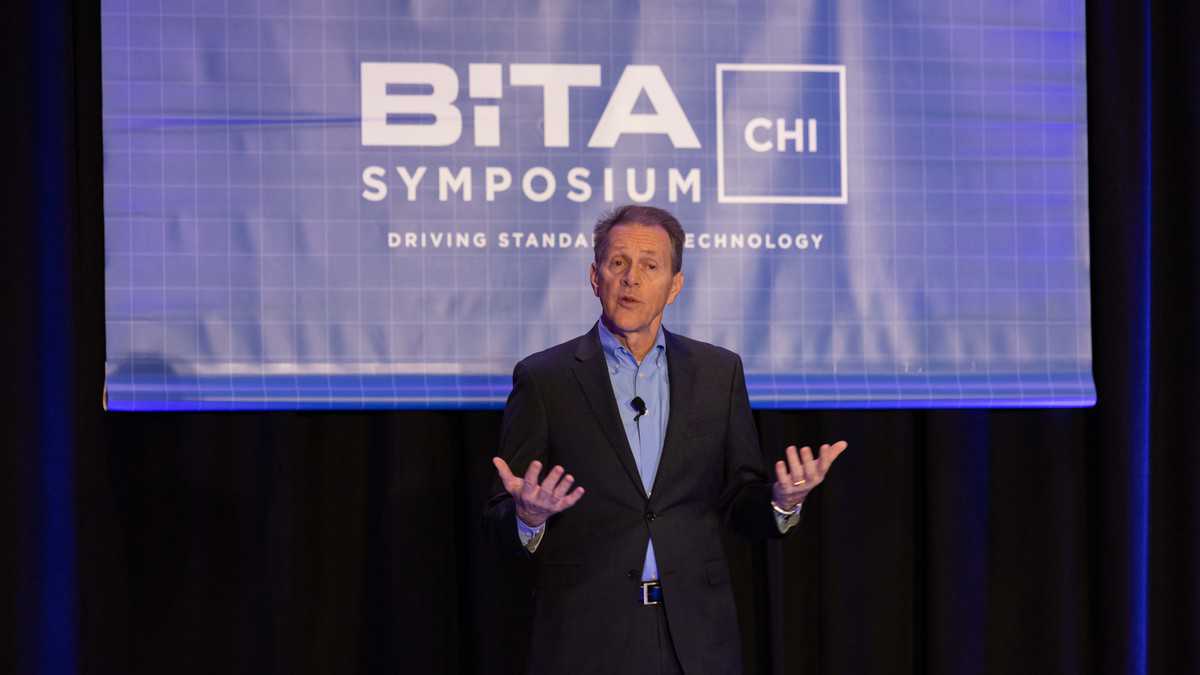Blockchain expert Dr. Mary Lacity, director of the Blockchain Center of Excellence at the Walton School of Business at the University of Arkansas, said increasing deployment of blockchain in businesses will coincide with a shift in how blockchain is presented to executives.
“How are we going to approach messaging with the C-suite,” she told the audience at the Blockchain in Transport Alliance’s BiTA Symposium Chicago at McCormick Place on Nov. 14, 2019. “They don’t want to hear about blockchain, they want to hear about value.”
Lacity spoke shortly after BiTA President Patrick Duffy opened the one-day symposium for BiTA members. “I’m expecting a big 2020; we will really accelerate things next year,” Duffy said. He noted that several proof of concept projects will be announced next year and pointed to real-world implementations that are beginning to take place.
The BiTA Symposium provided updates to members on the organization’s progress toward developing blockchain standards for the supply chain. Use case presentations were shown to attendees, and several speakers provided expertise on smart contracts, legal consequences and more at the event.
Following Duffy, Dale Chrystie, chair of the BiTA Standards Board and business fellow and blockchain strategist at FedEx, encouraged members to get involved in technical and working committees, where much of the behind-the-scenes work takes place.

“It’s a strong and enthusiastic group,” he said. “I thank you very much on behalf of the board.
Lacity followed Chrystie, and after a brief overview of the University of Arkansas’ blockchain programs – including the fact that 27 out of 30 graduate students entering the Walton School of Business this summer chose the blockchain track – explained the challenges blockchain faces at the C-suite level. She said that a research project found that of 36,000 10-k filings examined, only 242 mentioned blockchain or distributed ledger technology.
“Our C-suites are getting really fatigued by blockchain, so we have to shift the conversation to the value it provides,” she said.
Lacity encouraged the audience to “stick to the longer vision” of blockchain. In his remarks, Chrystie took notice of those that have abandoned blockchain at this point, believing it is more hype than reality. “I’m actually okay that people are [getting out],” he said. “That is leaving the rest of us to get it built.”
Lacity drew connections between blockchain in the supply chain and Bitcoin’s evolution since its introduction in 2009.
“When we move to shared ecosystems, you are not going to have control over the data,” she said, “so we have to create shared governance. All of us start off with centralized governance because there is real value in centralized governance… but you can’t stay with centralized governance. If you have 10 nodes with centralized governance, then you don’t really have a blockchain use case.”
Bitcoin also started with central governance, Lacity pointed out. “But now anyone can submit a change and the community debates it and eventually the miners decide whether the update [will be made].”
Many early blockchain projects in the supply chain are currently based on centralized governance, she added.
Dan Conway, associate director of the Blockchain Center of Excellence, said that standards for data, rules and processes are critical to blockchain’s success.
“I actually think standards are kind of fun because I get to talk to smart people around the world who want to overlay [artificial intelligence] over blockchain solutions,” he said.
Conway pointed to virtual road signs that determine which car should enter an intersection first as a use case for blockchain. Another, he said, involves connected cars in which one car makes a cryptocurrency payment to pass a slower moving vehicle. In commercial trucking, drivers could potentially be compensated for safe driving in real time.
Dr. Kiran Garimella, chief scientist and chief technology officer at KoreConX, said any blockchain platform needs to focus on businesses, none of which are an island by themselves, and all of which have ecosystems of customers and suppliers.
“It’s about understanding the ecosystem,” he said. “Where are the pain points and how do you add value?
“I personally feel that this industry – transportation – is ripe for transformation,” he added.
The morning session concluded with a case study about how Accenture is using blockchain to improve safety for its female workers in India.
Josh Cartellone, senior manager-Industry X.0 for Accenture Digital, said that only 23% of the workforce in India is female, but more importantly, 53% of women felt unsafe getting to and from work; 82% left work early to reduce their risk of being assaulted, and 91% feel the government is not improving public safety. Over a four-year period, there was a 39% increase in reports of rapes, Cartellone said.
To help improve its workers’ safety, Accenture partnered with BetterPlace, a background check company, to produce the Safe Driver program. The program places extensive background checks of drivers onto a blockchain that includes facial recognition technology. Drivers’ applications and background checks are verified by Accenture, and this information is made available to employees using the service. The result is that 90% of Accenture’s female employees felt safer when getting to work and there was a 76% increase in riders in the program, which existed prior to the deployment of blockchain.
“We didn’t change anything; we didn’t change drivers; we just added this so riders felt safer,” Cartellone said.
Cartellone said a worker could easily be replaced by cargo and the system would operate the same.
“Wouldn’t we want to know as customers that our equipment is being used correctly during the entire trip?” he asked. “It all starts with identity – it is the identity of people, of equipment of Internet of Things devices.”
Cartellone said that, among the supply chain, this type of blockchain system could work with driver scorecards, licensing, facility access, health checks of people or vehicles, work authorization, work history, driver logs, equipment status, and cargo status or condition.










